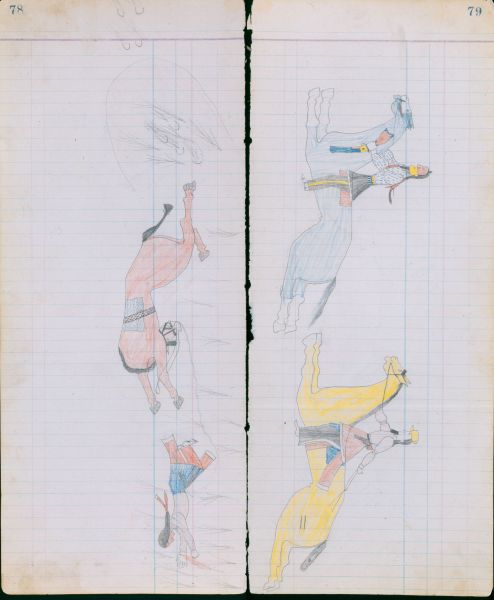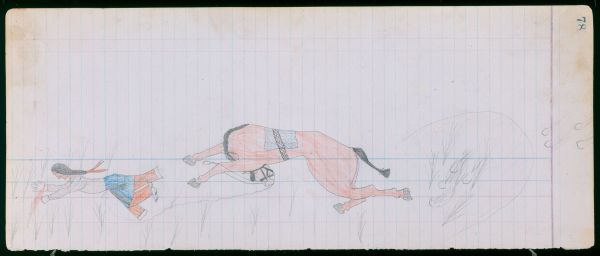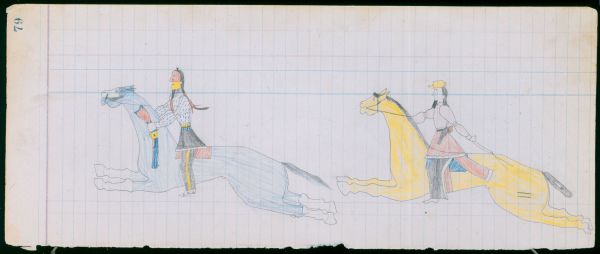PLATE 78-79
Ethnographic Notes
A riding accident is here portrayed, perhaps in the course of running buffalo, since the following three Plates pursue that theme. This is a separate occasion, however. We are meant to recognize that the men are hunting, because all of their horses have "work" bridles, rather than the silver-mounted headstalls reserved for social occasions, and for war. George Bent specified this distinction:
"Warriors...used nice bridles on their war horses; common bridles on their buffalo horses. They rolled up their lariat, and put it under their belt. If they fell off, they could always catch the ropes, and pull their horses back towards them. It would not do to let the rope drag on the ground. This would tangle up the horse's legs. This has happened lots of times in battle. This caused Indians getting killed by their enemies [because] their horses could not run, getting their legs all tangled up" (Bent, 1904-1918: May 6, 1918).
In the dual-perspective picture shown in Plate 78, all of the elements mentioned by Bent are depicted. The bay-colored horse is harnessed with a common bar-bit, or snaffle bit, over a commercial halter. A lariat is attached to the halter latch, just as is shown in Plate 74. The racing horse, approaching from the right of the composition, suddenly encountered a very steep declivity---represented by the long, curved line. The horse was forced to leap off this abrupt edge, into a patch of low bushes which probably represent willows. As it landed far down the slope, the horse's feet slid, represented by the scuffed lines. Either off balance, or possibly tripped by the brush, the horse fell, breaking its neck and simultaneously throwing the rider far forward where he has landed face down, scraping his hands and knees, and probably with the wind knocked out of him. The force of the fall has thrown the rider nearly to the length of his safety lariat, the coils of which have almost entirely been ripped out of his belt and lie on the ground, trailing back to the halter. The rider's seat was a simple blanket cinched as a pad to the horse's back. Note that the horse's tail has been carefully plaited, in anticipation of such hard riding.
Deadly falls like this were a common experience for Plain Indian riders:
"Accidents were frequent. Horses fell or were caught by cows and killed, guns burst, sometimes men were shot...Indian hunters have told me of men falling from their horses in such a way that whipstocks, arrows, bows and even guns were driven through their bodies" (Grinnell, 1913: 259).
Arrow, the artist, is riding the buckskin stallion in Plate 79, probably the same horse shown in Plates 76 & 80. The man ahead of Arrow, riding the blue roan, may be the Bowstring Society officer shown in Plate 21. It is likely that all three men are close relatives, possibly brothers or cousins from the same Nisson.
The Bowstring cousin carries an 1866 Winchester carbine, probably the same weapon shown in Plates 74 & 94. The cartridge belt he wears may be homemade:
"This belt is of hide, or preferrably of [commercial] leather, fastened in front with a buckle. On the outside a strip of buckskin is stitched in loops, each of the proper size to carry one cartridge. It is the ordinary 'service belt' of the army, somewhat roughly made" (Dodge, 1882: 423-24).
Note the very rare circumstance that the Cheyenne is not wearing a breechcloth. Instead, he has a pair of cavalry trousers with a yellow stripe down each leg. Undoubtedly these are a captured trophy. Compare these trousers with the leggings shown in Plate 76. Although the leggings have a similar yellow stripe, they are wider, and there is also the white selvedge of "saved list" trade cloth along the outer edge of the legging flap.
The rider of the blue roan wears fully-beaded moccasins, a blue, polka-dot shirt, beaded armbands with an 'H' design, a dentalium choker with red-painted spacers, and has his hair wrapped simply with red cloth. His face is painted in a horizontally-bisected design of red above yellow. A strong indication that Arrow and this man are Nisson relatives is the tiny, triangular "feather" attached to the top of his hair. Arrow wears a similar accent in Plates 80 & 86, although his is red. These are probably talismanic, and would have been prepared by the same spiritual advisor, who may also have made the war shields the two carried earlier.
Arrow's undecorated moccasins are worn with a pair of dark blue trade cloth leggings, and red wool breechcloth. Over these he has a red trade cloth blanket wrapped around his waist, and held in place with his holster belt. Silver armbands are worn over a pink cotton shirt. Arrow's hair is worn loose, under a yellow straw hat. Strapped to Arrow's left wrist is a quirt made from the tine of an elk antler. During the Battle of the Little Bighorn, the Northern Cheyenne Wooden Leg recalled:
"...I whacked the white man fighter on his head with the heavy elk-horn handle of my pony whip. The blow dazed him...he fell to the ground. I did not harm him further" (Marquis, 1931: 222).
Two parallel black lines painted on the left hip of Arrow's buckskin horse probably connote speed---see the discussion with Plate 7.
The injured man in Plate 78 wears a shirt with red and blue pinstripes; simple red trade cloth leggings and breechcloth; and partly-beaded moccasins with a simple, diagonal pattern around the foot. The blue wool blanket with a black band at either end is of the type often called a "Hudson's Bay" blanket. However, identical textiles were issued by the United States Indian Department to Plains tribes as annuities after 1851 (see MUSEUM OF THE FUR TRADE QUARTERLY, Spring 1976; Fall 1980 & Summer 1996). We have already seen one of these in Plate 34. Another appears in Plate 118.


